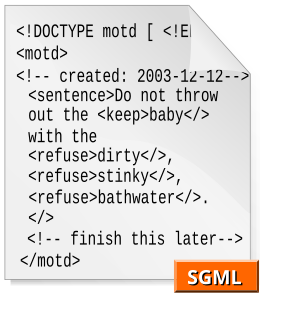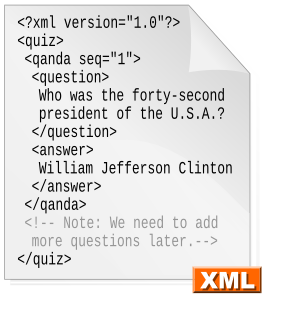
The Standard Generalized Markup Language is a standard for defining generalized markup languages for documents. ISO 8879 Annex A.1 defines generalized markup:-
Generalized markup is based on two postulates:
OML is an XML format for outlines. It was originally proposed by Ray Grieselhuber. The specification is designed to build upon the concepts found in OPML, with the goal of fixing some of its limitations.
Chemical Markup Language is an approach to managing molecular information using tools such as XML and Java. It was the first domain specific implementation based strictly on XML, first based on a DTD and later on an XML Schema, the most robust and widely used system for precise information management in many areas. It has been developed over more than a decade by Murray-Rust, Rzepa and others and has been tested in many areas and on a variety of machines.
A user interface markup language is a markup language that renders and describes graphical user interfaces and controls. Many of these markup languages are dialects of XML and are dependent upon a pre-existing scripting language engine, usually a JavaScript engine, for rendering of controls and extra scriptability.
RuleML is a global initiative, led by a non-profit organization RuleML Inc., that is devoted to advancing research and industry standards design activities in the technical area of rules that are semantic and highly inter-operable. The standards design takes the form primarily of a markup language, also known as RuleML. The research activities include an annual research conference, the RuleML Symposium, also known as RuleML for short. Founded in fall 2000 by Harold Boley, Benjamin Grosof, and Said Tabet, RuleML was originally devoted purely to standards design, but then quickly branched out into the related activities of coordinating research and organizing an annual research conference starting in 2002. The M in RuleML is sometimes interpreted as standing for Markup and Modeling. The markup language was developed to express both forward (bottom-up) and backward (top-down) rules in XML for deduction, rewriting, and further inferential-transformational tasks. It is defined by the Rule Markup Initiative, an open network of individuals and groups from both industry and academia that was formed to develop a canonical Web language for rules using XML markup and transformations from and to other rule standards/systems.
The following tables compare general and technical information for a number of document-markup languages. Please see the individual markup languages' articles for further information.
Office Open XML is a zipped, XML-based file format developed by Microsoft for representing spreadsheets, charts, presentations and word processing documents. The format was initially standardized by Ecma, and by the ISO and IEC in later versions.
Precision Graphics Markup Language (PGML) is an XML-based language for representing vector graphics. It was a World Wide Web Consortium (W3C) submission by Adobe Systems, IBM, Netscape, and Sun Microsystems, that was not adopted as a recommendation. PGML is a 2D graphical format, offering precision for graphic artists, guaranteeing that the design created will appear in end user systems with the correct formatting, layout and the precision of color.
The SVG Working Group is a working group created by the World Wide Web Consortium (W3C) to address the need for an alternative to the PostScript document format. The PostScript format was unable to create scalable fonts and objects without creating files which were inordinately larger than a file which used unscalable fonts and objects.
The Multimodal Interaction Activity is an initiative from W3C aiming to provide means to support Multimodal interaction scenarios on the Web.
Data exchange is the process of taking data structured under a source schema and transforming it into data structured under a target schema, so that the target data is an accurate representation of the source data. Data exchange allows data to be shared between different computer programs.
Machine-readable data, or computer-readable data, is data in a format that can be easily processed by a computer.
This page is based on this
Wikipedia article Text is available under the
CC BY-SA 4.0 license; additional terms may apply.
Images, videos and audio are available under their respective licenses.


